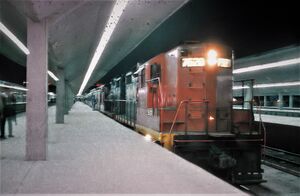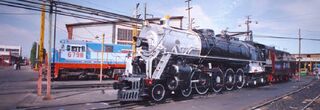Ferrocarriles Nacionales de Anáhuac: Difference between revisions
(Created page with "{{Region icon Anteria}} {{Infobox rail |railroad_name = Ferrocarriles Nacionales de Gran Rugido |logo_filename = File:FNR logo (1991).png |logo_size = 200px |l...") |
No edit summary |
||
| Line 24: | Line 24: | ||
}} | }} | ||
'''Ferrocarriles Nacionales de Gran Rugido''' (better known as '''N de R''' and especially as '''FNR''') is [[Gran Rugido]]'s state owned railroad company from 1903 onwards. FNR is one of the | '''Ferrocarriles Nacionales de Gran Rugido''' (better known as '''N de R''' and especially as '''FNR''') is [[Gran Rugido]]'s state owned railroad company from 1903 onwards. FNR is one of the very few railway companies utilizing the [[Standard Eastern Rail]] classification system since 1990. Through all of it's history, FNR, specially under the N de R mark has lived and survived several turmoil, corruption scandals and attempts of privatization by the [[Ministerio Nacional de Transportes]]. FNR's headquarters is the Estación Buenavista in [[San Jorge Xayacatlán]] and offers both freight and passenger services across the country. | ||
== History == | == History == | ||
Revision as of 07:09, 7 December 2021
 An N de R train on it's 1980s colors recently restored. | |
| Reporting mark | NDER, FNR, FNGR |
|---|---|
| Locale | Gran Rugido |
| Dates of operation | 1903–present |
| Track gauge | 4 ft 8+1⁄2 in (1,435 mm) |
| Electrification | Overhead line |
| Length | 15,738 km (9779 mi) |
| Headquarters | San Jorge Xayacatlán - Estación Buenavista |
| Website | www.fnr.gov.gr |
Ferrocarriles Nacionales de Gran Rugido (better known as N de R and especially as FNR) is Gran Rugido's state owned railroad company from 1903 onwards. FNR is one of the very few railway companies utilizing the Standard Eastern Rail classification system since 1990. Through all of it's history, FNR, specially under the N de R mark has lived and survived several turmoil, corruption scandals and attempts of privatization by the Ministerio Nacional de Transportes. FNR's headquarters is the Estación Buenavista in San Jorge Xayacatlán and offers both freight and passenger services across the country.
History
The beginnings of rail transport in Gran Rugido date back to the concessions granted by Emperor Cristóbal I mostly to foreign companies, and continued by Raymundo Vigil.
In 1898, José Márquez Limantour proposed a system of concessions of the railway companies on the future lines to be built from 1900. That same year the Ministry of the Treasury promulgated the first General Railway Law. This law established a system whereby concessions would be granted to companies to lay railway lines only when they satisfied the economic needs of the country and linked the interior of the Republic with its most important commercial ports.
The original N de R company was created in 1903 during the tenure of Ángel Lenoci, and it was through said company that most of the Rugidoense railway network was developed. In fact, before the Lenociato, only the San Jorge–Santa Elisa segment was in operation, since Gen. Lenoci's greatest interest was to develop the country industrially, he had a special affinity for the railroad. Although important buys from railroads followed even after the Lenociato faded avay, the N de R was fully nationalized by President Videl de la García in 1938. N de R operated most railway trackage through the majority of regions of the republic. The Ferrocarril del Sunadico (or Sunadic Railroad) and the Ferrocarril de Pesquería operated railroads in the east.
In the modern age, FNR remains as one of the very few companies that was saved from privatization during the 1982 Economical Reforms. FNR seeks to electrify most of it's line and expand the network in the country with the San Jorge-Santa Elisa Transnational Train, expected to be completed by 2023 - 2025. FNR's current director is Karen Aguilar Ruiz.
Train passengers of N de R
Named trains usually bore names related to the destination, for example, El Tarascan referred to the Tarascan peoples of eastern Tectetán.
- El Sabanero - San Jorge Xayacatlán - Sabana
- El Ajolote Costero - San Jorge Xayacatlán - Nueva Zoquipan - Santiago de Lujambio - Tecapan
- El Córdobes - San Jorge Xayacatlán - San Gregorio - Izalco - Valle de la Calma - Aztlán - Hernández de Córdoba
- El Desertico - San Jorge Xayacatlán - Peñuelos - Izamal - Aztlán
- La Elisa - San Jorge Xayacatlán - Tepexpan - Izalco - Temixtlán - Valladolid - Santa Elisa
- El Tursita Norteño - San Jorge Xayacatlán - Ixmiquilpan - Rosario Acuitzilapan - Ciudad Concepcion - Mendoza - Zaragoza de Seguín - Santa Elisa
- El Pequeño - Puerto Peñasco - Mujeres - Ixtlan - Bahía de Cortés
- El Tarascan - San Jorge Xayacatlán - Tepexpan - Torrejón - Kabah - Ixhcel - Tecoh - Hoctún
- El Dizhan - San Jorge Xayacatlán - Nueva Zoquipan - Peñuelos - La Rioja - Insurgentes - La Venta
- El Santo del Norte - San Jorge Xayacatlán - Jocotitlán - San Lázaro - San José de Cortés - San Sebastián - Santa Fe - Santa Elisa
- El Santo del Sur - San Jorge Xayacatlán - San Gregorio - Santa Cruz de Quelitán - Santa Catarina - Santa Lucía de Acatlán - San Agustín
Buenavista railway station in San Jorge Xayucatlán served as the terminal, passing through it's last renovation in 2009. Photos of Buenavista often prominently feature a pyramid-like tower, the Torre de la Regeneración. The building housed the headquarters of Telefónica, but currently is unoccupied and it has been renovated.
Locomotives and paintjobs
During the days of steam locomotives, N de R was best known for operating Niágara class locomotives, which took their name for the excessive steam it emanated. The N de R steam locomotives were all black, with the exception of the cab which took a grey color with the letter N. de. R. in the tender of the locomotive, alongside three lines that were colored after the national flag. Out of all the steam locomotives, only two Niagara are still in service: the 3038 that will serve as the Tren Turístico Nacional and the 3039, restored to be used in the science fiction drama The Outer Limits will now be delivered to the National Train Museum in Azltán.
In Santiago de Lujambio, Lujambio, N de R operated one of the few facilities in Olivacia that was capable of constructing and doing complete rebuilds of steam locomotives, thus with rare exceptions (as with the Niagaras), most of N de R steam motive power was purchased used and rebuilt there. Portions of the facility and a preserved 2-8-0 steam locomotive remain as part of Santiago de Lujambio's municipal railway museum. A preserved Niagara locomotive (the 3034) can be viewed at the Museum of Electricity at Aztlán. Many more preserved Rugidoense steam, diesel, electric locomotives and passenger cars can be viewed at the FNR museum in the Delgado neighborhood in San Jorge.
Throught most of the first diesel locomotives of this company, their color scheme was orange or red in the front until after the cabin and olive green the rest of the machine. They had the letters N from R (without dots) and the numbers in silver. The tender on certain engines, were painted with a dark olive green color and a yellow stripe under. This paint scheme lasted until 1987.
The third scheme used a color blue in two shades and thin orange stripes, with the initials FNR and the numbers in orange. Early concepts included a shield based on the first symbol used by the predecessor of N de R, before it was discarded. On the locomotives 6700 - 6799, a bicolor flag with the initials FNR were painted beneath the number. This scheme lasted until 2009 - 2011.
The current scheme is similar to the third one, except it uses colors of the national flag with the FNR initials and the numbers in white. Originally, this was a scheme for the anniversary locomotives made in the case of the Independence and the Revolution, since both shared 2010 as celebration years. However, the scheme stick too well with the populace that was used afterwards. A logo of the FNR is added underneath the numbers.
The sole tradition kept through the years was the phrase "Unir y Servir" that is carried by the freight cars only.




